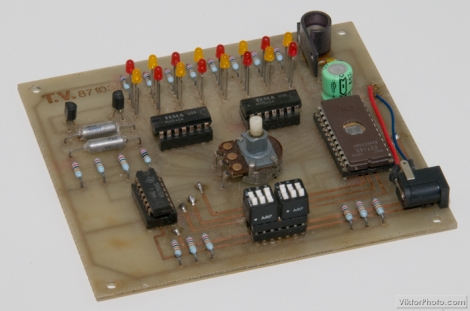
Building LED arrays that can display all sorts of different patterns is pretty easy these days. Hook up an Arduino, do some charlieplexing, and off you go. When [Viktor] was younger he didn’t have all those fancy schmancy microcontrollers and circuit simulation software you kids have these days. In fact, last we heard, he had to walk to school uphill both ways – in the snow.
That didn’t stop him from building this gem of a project back in 1987. His LED chaser/light show does not use any microcontrollers at all, rather it relies on an EPROM to store predefined display programs. A series of switches are installed on the front of the flasher, allowing him to easily switch between the programs, and a pot is mounted to the front of the device to control the speed of the LEDs.
His light show is pretty slick, even for a project built over 20 years ago. Sometimes you just can’t beat a good, old-school hack.
Continue reading for a video demonstration of [Viktor’s] programmable light show.
[youtube=http://www.youtube.com/watch?v=PcoXSnfaNaQ&w=470]
















What?
No 555?
(Imitating “You built a time machine… out of a DeLorean???”) you used two transistors… to generate a clock pulse???
Nice job!
@Jac Ever heard of an Multivibrator?! I made one of those on a PCB in 1st year university.
I like this, but after reading the description I could already imagine the circuit diagram. So I guess the kids these days still can understand somewhat older (but very elegant) techniques haha.
pffft this article is like 33 years old
kidding
i love the mid transistor age!
all you guys are smalltime, i made my own transistors to make a multivibrator.
@all
Not bad at all. Not at all. However that EPROM should really be wearing something opaque. A square of black electrical tape for example, or even a foil write protect tab, (remember them?) would also work the same as the tape.
The reason is that the UV components of an ordinary fluorescent light can cause that device to erase. But slowly, it takes about one to two weeks to slowly erase that way, the same as from the ordinary sun.
Cool, I’m using a similar method using a counter IC and a flash chip instead – no uC. However, my clock source is a 555 haha.
@GCL: I’m sure if it’s worked for over 24 years there’s not too much to worry about now.
@gdogg
Perhaps. But the one shown above isn’t wearing a cover. Perhaps it was put together simply for showing us the entire idea…..
Just last night I built a little LED light show on my breadboard using 7400’s and (of course) a 555. It has two switches, one to select the speed and one to select the movement direction. There are twenty LEDs, not counting the power indicator. Fun fun fun! I’ll post photos later.
[youtube http://www.youtube.com/watch?v=qc3bj2vrB8c&hl=en&fs=1%5D
built that for a lab assignment a few years back
DIP SWITCH!
come on, man, that deserved some Knight Rider music.. amirite?
Anecdote has it that back in high school (about the same “era” this thing was made) someone put together a very complex machine using a Z80 CPU – and of course, an EPROM. Which worked amazingly well, until the kid got some publicity and someone took some pictures of the thing. Using a flash. With the EPROM uncovered. After which the CPU started glitching and crashing like hell… ;)
Reminds me of this:
http://hackaday.com/2011/02/09/animating-an-led-matrix-without-a-microcontroller/
Posted less than a month ago…
Kudos for not using a 555!
Remember kids, if you can blink LED’s you can “blink” Mosfets and do this with 5000 watts of stage lighting.
Most DYI DJ lighting setups are lame as hell and need some flair like this.
Kids, let me tell you a story about look-up tables in PROMs…
mmm PRONs
Photo posted: http://www.facebook.com/photo.php?pid=6302360&l=d36e35bff4&id=752588531
Part list: 555, 7400, 7408, 7474, 7486, two 10-segment LED bar graphs, LED power indicator, two SPDT switches, two capacitors and ten resistors (values to taste), wires, 5V power supply.
ps. The “Download” link on that page will give you a much higher resolution image clearly showing all the individual wires. Facebook used to say “Download in High Resolution”, but I guess they become afraid that the large number of syllables in “Resolution” would scare away their users.